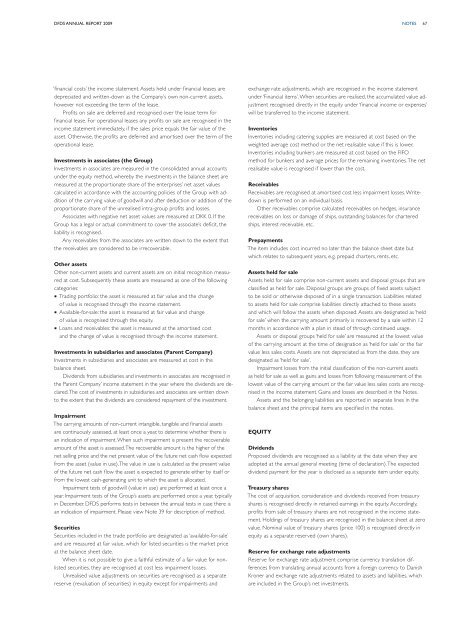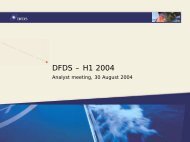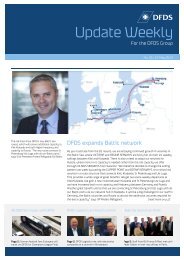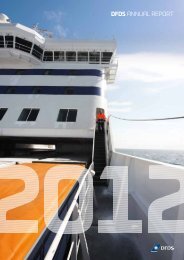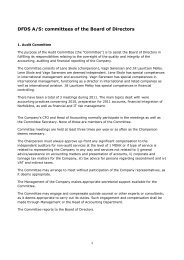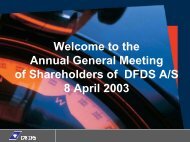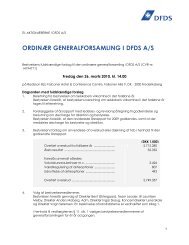English - DFDS
English - DFDS
English - DFDS
You also want an ePaper? Increase the reach of your titles
YUMPU automatically turns print PDFs into web optimized ePapers that Google loves.
<strong>DFDS</strong> annual report 2009 NOTEs 67<br />
‘financial costs’ the income statement. Assets held under financial leases are<br />
depreciated and written-down as the Company’s own non-current assets,<br />
however not exceeding the term of the lease.<br />
Profits on sale are deferred and recognised over the lease term for<br />
financial lease. For operational leases any profits on sale are recognised in the<br />
income statement immediately, if the sales price equals the fair value of the<br />
asset. Otherwise, the profits are deferred and amortised over the term of the<br />
operational lease.<br />
Investments in associates (the Group)<br />
Investments in associates are measured in the consolidated annual accounts<br />
under the equity method, whereby the investments in the balance sheet are<br />
measured at the proportionate share of the enterprises’ net asset values<br />
calculated in accordance with the accounting policies of the Group with addition<br />
of the carrying value of goodwill and after deduction or addition of the<br />
proportionate share of the unrealised intra-group profits and losses.<br />
Associates with negative net asset values are measured at DKK 0. If the<br />
Group has a legal or actual commitment to cover the associate’s deficit, the<br />
liability is recognised.<br />
Any receivables from the associates are written down to the extent that<br />
the receivables are considered to be irrecoverable.<br />
Other assets<br />
Other non-current assets and current assets are on initial recognition measured<br />
at cost. Subsequently these assets are measured as one of the following<br />
categories:<br />
n Trading portfolio: the asset is measured at fair value and the change<br />
of value is recognised through the income statement.<br />
n Available-for-sale: the asset is measured at fair value and change<br />
of value is recognised through the equity.<br />
n Loans and receivables: the asset is measured at the amortised cost<br />
and the change of value is recognised through the income statement.<br />
Investments in subsidiaries and associates (Parent Company)<br />
Investments in subsidiaries and associates are measured at cost in the<br />
balance sheet.<br />
Dividends from subsidiaries and investments in associates are recognised in<br />
the Parent Company’ income statement in the year where the dividends are declared.<br />
The cost of investments in subsidiaries and associates are written down<br />
to the extent that the dividends are considered repayment of the investment.<br />
Impairment<br />
The carrying amounts of non-current intangible, tangible and financial assets<br />
are continuously assessed, at least once a year, to determine whether there is<br />
an indication of impairment. When such impairment is present the recoverable<br />
amount of the asset is assessed. The recoverable amount is the higher of the<br />
net selling price and the net present value of the future net cash flow expected<br />
from the asset (value in use). The value in use is calculated as the present value<br />
of the future net cash flow the asset is expected to generate either by itself or<br />
from the lowest cash-generating unit to which the asset is allocated.<br />
Impairment tests of goodwill (value in use) are performed at least once a<br />
year. Impairment tests of the Group’s assets are performed once a year, typically<br />
in December. <strong>DFDS</strong> performs tests in between the annual tests in case there is<br />
an indication of impairment. Please view Note 39 for description of method.<br />
Securities<br />
Securities included in the trade portfolio are designated as ‘available-for-sale’<br />
and are measured at fair value, which for listed securities is the market price<br />
at the balance sheet date.<br />
When it is not possible to give a faithful estimate of a fair value for nonlisted<br />
securities, they are recognised at cost less impairment losses.<br />
Unrealised value adjustments on securities are recognised as a separate<br />
reserve (revaluation of securities) in equity except for impairments and<br />
exchange rate adjustments, which are recognised in the income statement<br />
under ‘Financial items’. When securities are realised, the accumulated value adjustment<br />
recognised directly in the equity under ‘financial income or expenses’<br />
will be transferred to the income statement.<br />
Inventories<br />
Inventories including catering supplies are measured at cost based on the<br />
weighted average cost method or the net realisable value if this is lower.<br />
Inventories including bunkers are measured at cost based on the FIFO<br />
method for bunkers and average prices for the remaining inventories. The net<br />
realisable value is recognised if lower than the cost.<br />
Receivables<br />
Receivables are recognised at amortised cost less impairment losses. Writedown<br />
is performed on an individual basis.<br />
Other receivables comprise calculated receivables on hedges, insurance<br />
receivables on loss or damage of ships, outstanding balances for chartered<br />
ships, interest receivable, etc.<br />
Prepayments<br />
The item includes cost incurred no later than the balance sheet date but<br />
which relates to subsequent years, e.g. prepaid charters, rents, etc.<br />
Assets held for sale<br />
Assets held for sale comprise non-current assets and disposal groups that are<br />
classified as held for sale. Disposal groups are groups of fixed assets subject<br />
to be sold or otherwise disposed of in a single transaction. Liabilities related<br />
to assets held for sale comprise liabilities directly attached to these assets<br />
and which will follow the assets when disposed. Assets are designated as ‘held<br />
for sale’ when the carrying amount primarily is recovered by a sale within 12<br />
months in accordance with a plan in stead of through continued usage.<br />
Assets or disposal groups ‘held for sale’ are measured at the lowest value<br />
of the carrying amount at the time of designation as ‘held for sale’ or the fair<br />
value less sales costs. Assets are not depreciated as from the date, they are<br />
designated as ‘held for sale’.<br />
Impairment losses from the initial classification of the non-current assets<br />
as held for sale as well as gains and losses from following measurement of the<br />
lowest value of the carrying amount or the fair value less sales costs are recognised<br />
in the income statement. Gains and losses are described in the Notes.<br />
Assets and the belonging liabilities are reported in separate lines in the<br />
balance sheet and the principal items are specified in the notes.<br />
Equity<br />
Dividends<br />
Proposed dividends are recognised as a liability at the date when they are<br />
adopted at the annual general meeting (time of declaration). The expected<br />
dividend payment for the year is disclosed as a separate item under equity.<br />
Treasury shares<br />
The cost of acquisition, consideration and dividends received from treasury<br />
shares is recognised directly in retained earnings in the equity. Accordingly,<br />
profits from sale of treasury shares are not recognised in the income statement.<br />
Holdings of treasury shares are recognised in the balance sheet at zero<br />
value. Nominal value of treasury shares (price 100) is recognised directly in<br />
equity as a separate reserved (own shares).<br />
Reserve for exchange rate adjustments<br />
Reserve for exchange rate adjustment comprise currency translation differences<br />
from translating annual accounts from a foreign currency to Danish<br />
Kroner and exchange rate adjustments related to assets and liabilities, which<br />
are included in the Group’s net investments.


